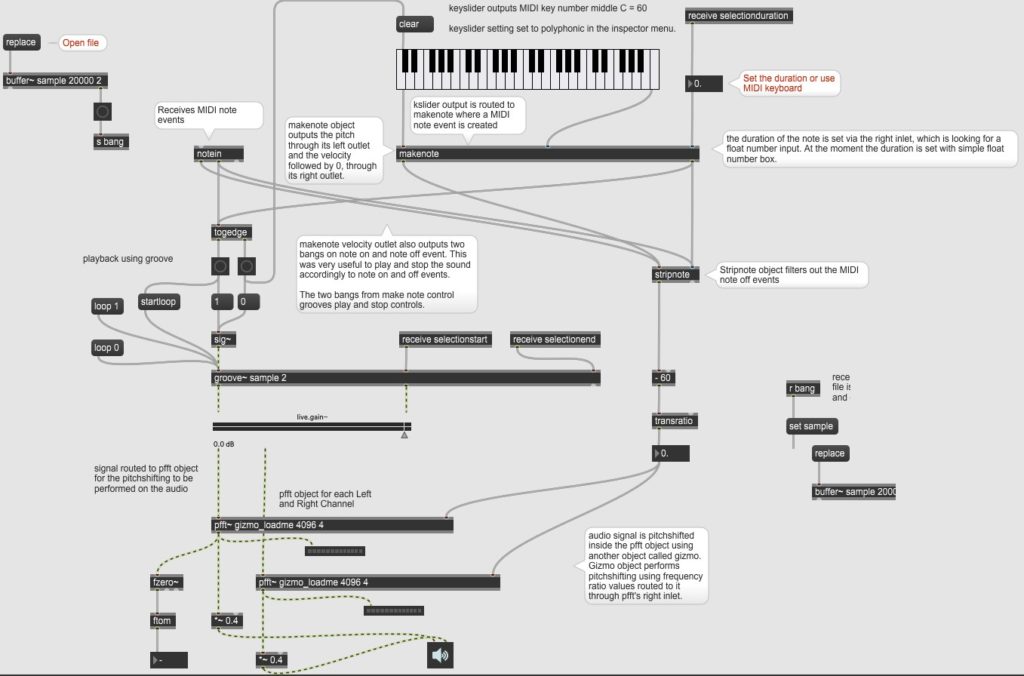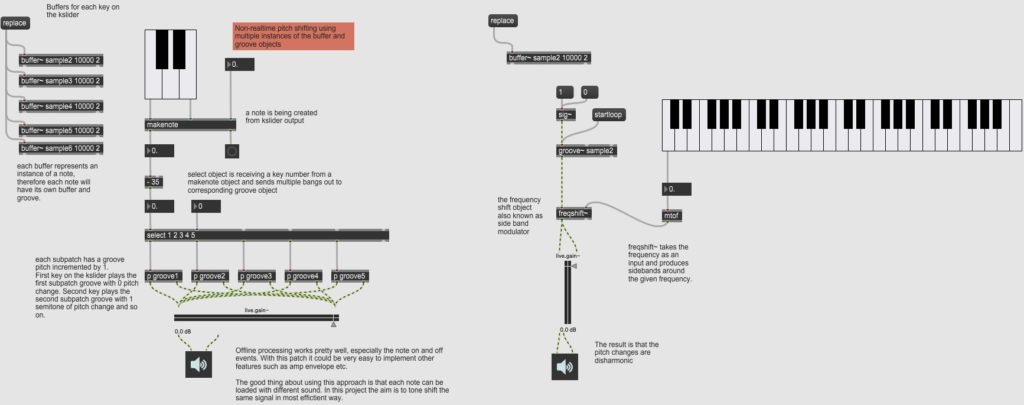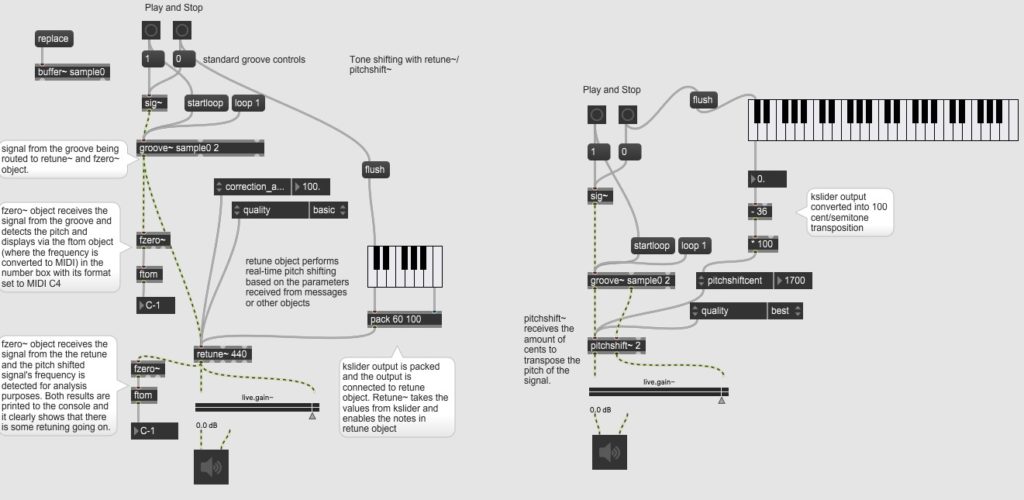Pitch Shift Study with MaxMSP
Main Goal
The most important intention of the patches is to pitch shift the use of the satisfactory object in Max, selected because of deep analysis of the exceptional strategies of pitch transferring inside the program as properly. To do that, you need to study the time and frequency domain names, and the deep intricacies of frequency moving and pitch shifting in phrases of how it impacts the notion of pitch. Using the newfound know-how in the observe, use practical pitch shifting and trace the sign route explaining the degrees it goes via.
Methods
There are few different ways in which the pitch of the signal can be transposed by different objects. Various objects use different algorithms to shift the pitch and these objects can be designated for multiple purposes. The two main types of pitch handling in Max include realtime pitch shifting based on ZTX and frequency domain.
Findings
The edits of the patches had been developed primarily based at the techniques described in the above phase. Each edit demonstrates the use distinctive methods to transpose the audio signals pitch.
Max Files:
- Edit One: Gizmo~ in pfft~ – “GizmoPFFTPitchShifting.
maxpat ”

- Edit Two: “Offline” Pitch Shifting/Frequency Shifting (Grooves, Buffers) – “Pitch-FrequencyShiftingOfflineGroove.
maxpat ”

- Edit Three: ZTX-based pitch shifting with retune~/pitchshift~ –“ZTXReal-
timePitchShifting ”

Frequency Shifting — Pitch Shifting (Edit Two-Edit One)
Comparing those two gadgets (freqshift~ and gizmo~) and how they correlate, there may be a great difference within the way the item affects the signal. Both objects exchange the signed frequency and affect its pitch in diverse ways. The distinction is that the object “freqshift~” changes the pitch of the signal and destroys the harmonic relation of the elements within the frequency spectrum of the sign. On the opposite hand, the gizmo item that actions the pitch in the “pfft~ ” item (the usage of real and imaginary alerts furnished via the FFT protocol (ftin~ item)) retains the harmonic content material of the sign.
“Online” — “Offline” Pitch Shifting (Edit Two-Edit One)
Comparing the frequency domain pitch shift with the offline processing in phrases of reminiscence and CPU performance, it’s miles like ZTX-based totally tech, the gizmo~ interior pfft~ additionally pitch shifts in real-time. The way the “buffer~” or “polybuffer~” gadgets paintings is they place the sound file directly inside the RAM. Both processes use a buffer to store the audio report in real time and offline. The difference is that during significant most effective one buffer per audio sample is required, where offline processing calls for one buffer in line with a key on a keyboard. It is not at all efficient to evaluate the frequency area pitch shift with “gizmo~” within the object “pfft~”. This approach that each content of the buffers might have to be processed individually if an audio impact changed into to be implemented to the signal.
Edit Three
It was already observed that a few objects work better, and some seem that they’re hardly attending to work. For instance, the “retune~” object identified within the previous venture is ZTX-based totally real-time pitch detection and pitch shifting processor and the actual reason of this item is to music the signal to unique frequency. This is the purpose of this mission however in truth not in the case of ZTX-based generation, or at the least the “retune~” object. The originator of ZTX-based totally technology, ZynaptiQ says that “ZTX is a move-platform era for excessive satisfactory time stretching, pitch moving, formant moving, and pitch correction.” Indeed, ZTX will be greater relevant to real-time audio processing along with time-stretching even as for example preserving the authentic pitch of the audio. The 1/3 edit demonstrates the basics of the ZXT-based pitch moving.
Results
The result of the experiments determines the Gizmo~ item to be the winner of the lengthy going warfare. The decision is unequivocal because of the records observed and defined above within the document. Not most effective that the Gizmo~ object running with the FFT protocol is particularly efficient, the nice of pitch shifting is excessive enough to overcome different objects.
Looking at the first edit, the stereo signal output by the groove~ object is routed through the live gain~ item into the left inlets of two separate pfft~ – one for each channel. This does now not make
The fftin~ object receives the signal from the pfft~ left inlet. The sign is processed in the fftin~ object and is divided into
Conclusion
The patches heightened my information of different domain names, frequency, pitch, but specifically the FFT protocol. The experiments carried out had an enormous impact on the effects of the patches and permit harmonious changes in many finalities, but most importantly ended in extra know-how and expertise of what goes on inside the patch.
Further details had been located within the patches, frequency and pitch elements of digital audio. Although frequency is without delay related to our perception of pitch, there is a notably special combination of those parameters in Max, where a frequency shift is not a pitch shift, as ould would possibly assume. If you have a look at the pitch and frequency manipulation in Max, it is far critical to understand the domain inside which the item operates. For instance, the freqshift~ is a frequency shifter in the time area and the gizmo~ object is a frequency pitch shifter. These styles of variations can be tough, so it is far very critical to research them in addition in order that the domain names are absolutely understood, and any uncertainties are clear. This step becomes essential with the intention to delve into the FFT. In terms of sound, the real and imaginary ideas and the FFT standards have been completely new, but they quickly gained a whole lot of interest because of their captivating performance, but also because they had been the proper solution for plenty elements of digital sound. In the future, it might be interesting to investigate the set of rules that mixes the reverse order of the spectra with the sign decomposition.
